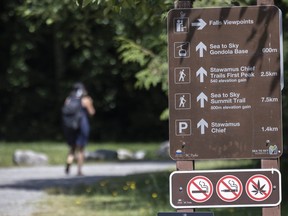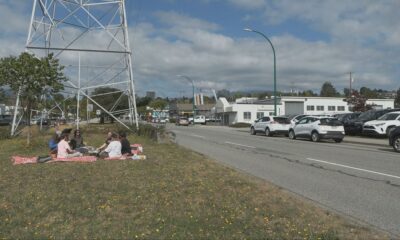World
Surge in Wilderness Injuries Linked to Risky Behaviour in B.C.

Metro Vancouver search-and-rescue teams are raising alarms about a troubling increase in injuries and fatalities in the wilderness this summer. The North Shore has seen a notable rise in risky behaviour, prompting experts to stress the importance of safety preparations for outdoor enthusiasts.
Search-and-rescue groups report that six people have died and three remain missing in the Sea to Sky region this year. These incidents highlight a pattern of reckless decisions by hikers, many of whom venture into the wilderness without adequate preparation or awareness of potential hazards.
Sandra Riches, executive director of B.C. AdventureSmart, attributes much of the increase in rescue calls to a lack of preparation. She notes that while extensive resources are available, such as trail planning assistance and safety tips on the AdventureSmart website, many individuals overlook these tools. The program, managed by the B.C. Search and Rescue Association, provides advice for popular trails like the Grouse Grind and Mount Seymour.
Riches emphasizes that 95 percent of search-and-rescue cases involve local residents, primarily hikers, followed by mountain bikers and ATV users. Many individuals embark on their adventures without considering emergencies, often pushing the limits by entering dangerous areas in search of the perfect photo.
“Not everyone knows how to use a map and a compass together. They’re not familiar with reading a map, let alone planning their adventure,” Riches stated. “People are going beyond their means, beyond their skill, beyond their training.”
The influence of social media plays a significant role in this trend. Riches points out that many individuals see images of friends and influencers enjoying outdoor activities and feel compelled to recreate those experiences, often without understanding the associated risks.
“It looks very enticing. And everyone thinks, ‘Hey, I can do that,’” she added. Riches advocates for a shift in how social media users present their adventures, suggesting they should share the effort and training involved, thereby fostering a better understanding of the challenges that outdoor activities entail.
While representatives from North Shore Rescue did not respond by deadline, spokesman Doug Pope mentioned to local media that he cannot recall such a troubling start to the search-and-rescue season. Riches believes that many incidents could be avoided by adhering to the three Ts: Trip planning, training, and taking the ten essentials, all of which can be found on the AdventureSmart website.
The B.C. Search and Rescue Association reported that there were 1,960 search-and-rescue tasks in 2022, a figure that has steadily increased over the past decade. Most hikers requiring rescue are between the ages of 20 and 29, a demographic that may be less inclined to use safety resources, particularly if they have previous hiking experience.
“I can guarantee you that a lot of young people see the cool shots on Instagram and say, ‘I’ve got to go there,’ even though they have little or no experience,” said Ian MacDonald, a spokesman for Coquitlam Search and Rescue. “They never go to AdventureSmart. That’s too old-school for them.”
MacDonald warns that even seasoned hikers can make critical mistakes, such as starting long hikes too late in the day. A common error involves beginning an eight-hour trek at 14:00, which can lead to dangerous situations as daylight fades.
The number of rescue calls in Coquitlam has remained average this year; however, MacDonald expresses concern over fatalities on the North Shore, noting that similar issues can arise on any trail. June, in particular, is a hazardous month due to melting snow creating slippery conditions.
Another warning comes from Brent Boulet, president of Ridge Meadows Search and Rescue. He observes that more inexperienced individuals are venturing into alpine areas during late spring and early summer.
“Search and rescue teams across B.C. have seen a rise in call volumes in recent years that is likely fuelled by social media,” Boulet said. “Some people don’t understand that winter conditions extend into the summer in the mountains.”
MacDonald advises against relying solely on Google Maps for navigation in the wilderness, as it can often be unreliable. He stresses the importance of carrying a physical map of the trails.
Visitor numbers to B.C. parks continue to increase, contributing to the surge in rescue calls. According to the provincial government, there have been 283,743 bookings at B.C. parks from January to June 2023, compared to 251,285 during the same period last year.
As the summer progresses, search-and-rescue teams are calling for greater awareness and responsibility among outdoor enthusiasts. The goal is to ensure that individuals enjoy the beauty of B.C.’s wilderness while prioritizing their safety and preparedness.
-

 World3 months ago
World3 months agoScientists Unearth Ancient Antarctic Ice to Unlock Climate Secrets
-

 Entertainment3 months ago
Entertainment3 months agoTrump and McCormick to Announce $70 Billion Energy Investments
-

 Lifestyle3 months ago
Lifestyle3 months agoTransLink Launches Food Truck Program to Boost Revenue in Vancouver
-

 Science3 months ago
Science3 months agoFour Astronauts Return to Earth After International Space Station Mission
-

 Technology2 months ago
Technology2 months agoApple Notes Enhances Functionality with Markdown Support in macOS 26
-

 Top Stories1 week ago
Top Stories1 week agoUrgent Update: Fatal Crash on Highway 99 Claims Life of Pitt Meadows Man
-

 Sports3 months ago
Sports3 months agoSearch Underway for Missing Hunter Amid Hokkaido Bear Emergency
-

 Politics2 months ago
Politics2 months agoUkrainian Tennis Star Elina Svitolina Faces Death Threats Online
-

 Technology3 months ago
Technology3 months agoFrosthaven Launches Early Access on July 31, 2025
-

 Politics3 months ago
Politics3 months agoCarney Engages First Nations Leaders at Development Law Summit
-

 Entertainment3 months ago
Entertainment3 months agoCalgary Theatre Troupe Revives Magic at Winnipeg Fringe Festival
-

 Politics1 week ago
Politics1 week agoShutdown Reflects Democratic Struggles Amid Economic Concerns





















